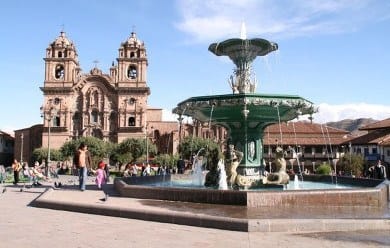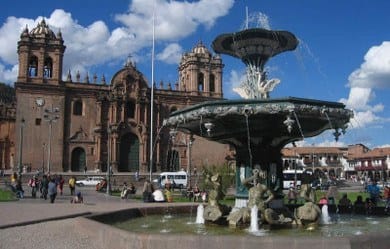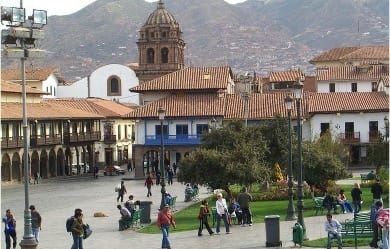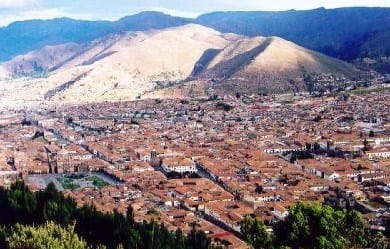We offer a world-renowned TEFL / TESOL certification course in Cusco, Peru that prepares you for teaching English overseas, or in your home country. Our TEFL certification courses last for four weeks and have a very practical emphasis. There is no need to speak any language other than English, as our courses concentrate on training you to teach English with the international standard communicative approach – where English is the only language used in the classroom.
This is the most practical and fundamental area of any TEFL training course. During the teaching practice sessions, trainees have the opportunity to teach real students of English and put into practice the skills learnt during the theoretical parts of the course.
2) Foreign Language Experience
During the course, trainees receive instruction in an unknown foreign language to help them reflect on the experience of being a learner. This session is extremely useful in creating empathy between the teacher and student and should help trainees to direct their own teaching.
3) Language Awareness
a) This area focuses on grammar and covers subjects such as parts of speech, the structure of tenses, conditionals and modals and other common grammar points. During these sessions trainees learn about these subjects as well as ways to teach them to their future students in the classroom.
b) This area also looks at the subject of phonology and covers phonemics, word and sentence stress, intonation and connected speech.
4) Student Profile
For this part of the course, each trainee is required to work with an individual student in order to work on things such as rapport building, error analysis, correction techniques and addressing individual student needs. Three meetings with the student are required to complete the profile, after which the trainee completes a one-to-one lesson with their student. The final stage is the completion of a written report regarding the lesson.
5) Teaching Techniques
This component of the course covers areas such as:
- Lesson planning
- Classroom management
- Establishing rapport
- Discipline in the classroom
- Managing equipment and teaching aids
- Creating materials
- Correction techniques
- Evaluation and testing
- Teaching vocabulary
- Teaching grammar
- Teaching receptive skills (reading and listening)
- Teaching productive skills (speaking and writing)
- Games in the classroom
- Songs in the classroom
- Teaching beginner students
- Teaching individual students
6) Materials Project
All trainees are required to create their own set of materials to be used during the teaching practice. These materials will be useful in future teaching environments and will help to instill the benefits of creativity and resourcefulness in relation to your lesson planning. The materials should be easily portable, durable and adaptable for different lesson points.
Once you have created your materials project you will present it to a course trainer and demonstrate how it will be used in the classroom. Your trainer will then provide advice and suggestions on how they can be improved and how they could be used in another context.
Apply Today
All applications from candidates aged 18 (younger ages may be considered in exceptional circumstances) and above will be considered for our English teaching courses. Our in-class TEFL courses are intensive, four-week programs; however, all trainees should still have sufficient time to explore the local area, experience the culture and to meet new people. Also, individual course organizers will often arrange leisure activities for our trainees so they can socialize in their spare time and make the most of their experience.
Course fees
The total price is divided into: deposit and balance.
The deposit may be paid via a) credit card b) PayPal c) wire transfer d) Western Union.
The balance of the course fee must be paid by cash, PayPal or bank transfer directly to the training center on the first day of the course.
Reviews
TEFL Cusco | TEFL Peru
Join our TEFL course in Peru and experience life at the nexus of prehistory and modern culture. Cusco is undoubtedly one of the best locations to take your TEFL course in South America. As if that isn’t enough, once your course is finished, we will provide you with lifetime assistance finding employment. Teaching English in Peru is a great experience and our TEFL course in Cusco has proved to be increasingly popular.
Considered the gateway to Machu Picchu, one of the new Seven Wonders of the World, Cusco is a wonderful city to visit and explore. Though many people think of it as a small village, Cusco is actually a bustling city of 400,000 people. There is a plethora of museums, markets, cultural and historical sites within the city limits that are easily accessible and visited. Likewise, there are a number of day and weekend trips, treks and adventure tours available to surrounding villages and archaeological sites such as Sacsaywaman, Q’oricancha, and the Sacred Valley. Our TEFL course in Peru is your passport to job opportunities in exotic and culturally fascinating locations the world over. However, after gaining tefl certification in Cusco, you may never want to leave this amazing place again. If you choose our TEFL course in Cusco, you will be training in well-equipped classrooms with real Spanish-speaking students. Our training centre in Cusco has modern facilities and provides an excellent environment to study for your teaching qualification. In your free time you can visit the Incan city of Machu Picchu or go hiking in the breathtakingly beautiful Sacred Valley.
Apply to take our TEFL course in Peru now and soon you could be experiencing life in the Mecca of South America and one of the most sought-out travel destinations in the world. If you do choose to train here, it doesn’t mean you have to stay and teach in Peru. If you would like to move on after the course, we offer lifetime assistance finding employment and our certificates are recognised worldwide.
The School
The ITTT training centre is located in downtown Cusco, just 2 blocks from the famous Plaza de Armas and across the street from the majestic Q’oricancha, the most important temple in the Incan empire which became a breathtaking Spanish colonial church. The main TEFL classroom is spacious, comfortable, and well-equipped. The institute includes a small cafe, large common areas, free Wi-Fi, and a computer lounge with internet. There are also a variety of restaurants and banks nearby. Wireless internet access and the computer lounge are available at the school seven days per week.
Accommodation
We have a number of accommodation options available for students taking our TEFL course in Peru, including home stays, private apartments and hostels. If notified in advance, our centre in Peru can arrange a home stay for you in Cusco which will include a private bedroom in the home of a local family, as well as breakfast and dinner seven days per week. This option provides an opportunity to practice your Spanish skills, as well as giving you an authentic experience of the Peruvian culture. Please note that home stay accommodation should be secured at least one month prior to the course start date.
Alternative accommodation includes local hotels, hostels, and private apartments. Once your place has been confirmed on the TEFL course, we will send you further information on the accommodation available to help you choose the option that best suits your personal requirements.
Accommodation Fees
The accommodation fees are not part of the course price and you are free to choose whichever accommodation option you prefer.
You are not obliged to use the accommodation provided by the school and you are welcome to make your own accommodation arrangements. If you choose to use our accommodation, it should be paid for either by cash, PayPal or bank transfer directly to the school at the start of the course.
Reviews
FAQs
What are my payment options?
The deposit for the course must be paid to our administrative centre. The fastest and cheapest way to do this is by credit/debit card, but payments via Western Union, PayPal and bank transfer are also acceptable. While there are no deadlines for making a deposit, places can fill up quickly and your seat on the course will only be reserved once the deposit payment has been made.
Once the deposit has been paid, you will receive an information packet via email with detailed information about the course in Peru.
The balance of the course fees is payable in cash, by credit/debit card or via PayPal. The balance is due before the start of your course. Once you have contacted the Peru centre and made your accommodation and course package selections, you will be emailed an invoice outlining additional payment instructions. Please ensure that you read the welcome information that you will receive from the Peru centre so that you are aware of the materials you will be required to bring for the course and what services are available at our overseas centre.
What are my accommodation options?
Staying with a local family is our recommended accommodation option for trainees during their time on the Peru TEFL course. The home stay option is designed to give trainees an authentic taste of life in Peru in a family atmosphere. Students will be provided with a private room in the home of a local family and receive traditional meals for breakfast and dinner each day. All families have been chosen for their warmth and interest in hosting foreign students and are located within 10-20 minute walk or a 5-15 minute bus/taxi ride away from the TEFL school. The cost of this option is US$ 595 in 2015, or US$ 630 in 2016.
The second accommodation option is a private apartment that can be rented at a cost of US$ 450 in 2015, or US$ 495 in 2016.
Accommodation for the course is available from the day before the first day of the course through to the day after the last day of the course. If you choose to arrive before or stay after the course, you may do so based on availability and at an extra cost.
Students are also free to make their own accommodation arrangements within the Cusco area.
What travel documents will I need for Peru?
Visitors to Peru from the USA, Canada, Australia, New Zealand, the UK, and the European Union nations can enter the country without a visa. Visitors to Peru are required to carry a passport valid for at least six months after their arrival date and can remain in the country 90 days. As you move through Immigrations, you can ask for a 183 day tourist visa. This is not provided automatically, but is usually granted on request.*
* As this information is subject to change at any time, we advise you to contact your local consulate for current travel regulations prior to planning your trip. For more information on obtaining visas please check with your local Peruvian consulate or embassy.
What is the course schedule?
The course is full time over four weeks. The course runs from a Monday to a Friday or from a Wednesday to a Tuesday depending on the month you sign up for. The first two weeks comprise of six hours of classroom work every day, with two 15 minute breaks and one hour for lunch. The last two weeks of the course are spent on lesson planning and teaching practice. On the first day of your course you should arrive for orientation at 9:00 AM. At this time you will be given a detailed course timetable. On the last day of the course there will be a graduation party, so you should plan your departure from Cusco around this if possible.
What can I expect during teaching practice?
Teaching practice takes place with local Peruvian students who are keen to study and are enthusiastic learners. We do not charge these students to attend classes so you can be sure that they are there because they want to be.
Who usually attends the course?
Course numbers are typically around 5 – 15 trainees. If the number exceeds 18, we will divide trainees into two groups taught simultaneously. Most course participants are American, British, Canadian or Australian though the course is open to non-native speakers who have a high proficiency in English.
Is there a dress code?
During trainees’ lessons, casual attire is allowed. The key to packing for a trip to Peru, and Cusco more specifically, is to pack for a variety of conditions. Cusco experiences intense sun during the day and cold mountain nights that remind you that you’re at 11,200 feet/3,400 meters. For trips outside of Cusco into the Amazon Basin or to the Sacred Valley and Machu Picchu, you should prepare for the heat and humidity there. During teaching practice, you will need to dress in trousers/skirts and closed-toe shoes. Men will need to wear collared shirts, and women will need to wear conservative tops that cover their shoulders. Men should be clean shaven or keep facial hair neatly trimmed. No visible tattoos or facial piercings are allowed while teaching local students.
What should I bring for course studies?
Please be sure to arrive on the first day of the course with a notebook and a pen. We strongly recommend you also bring a laptop as we have Wi-Fi at the training centre.
What documents do I need for finding employment after the course?
Of course, you will need your passport. When you secure work you may also be asked to provide copies of your birth certificate, college degrees and transcripts. You might also consider obtaining an international driving permit if you want to drive in Peru.






